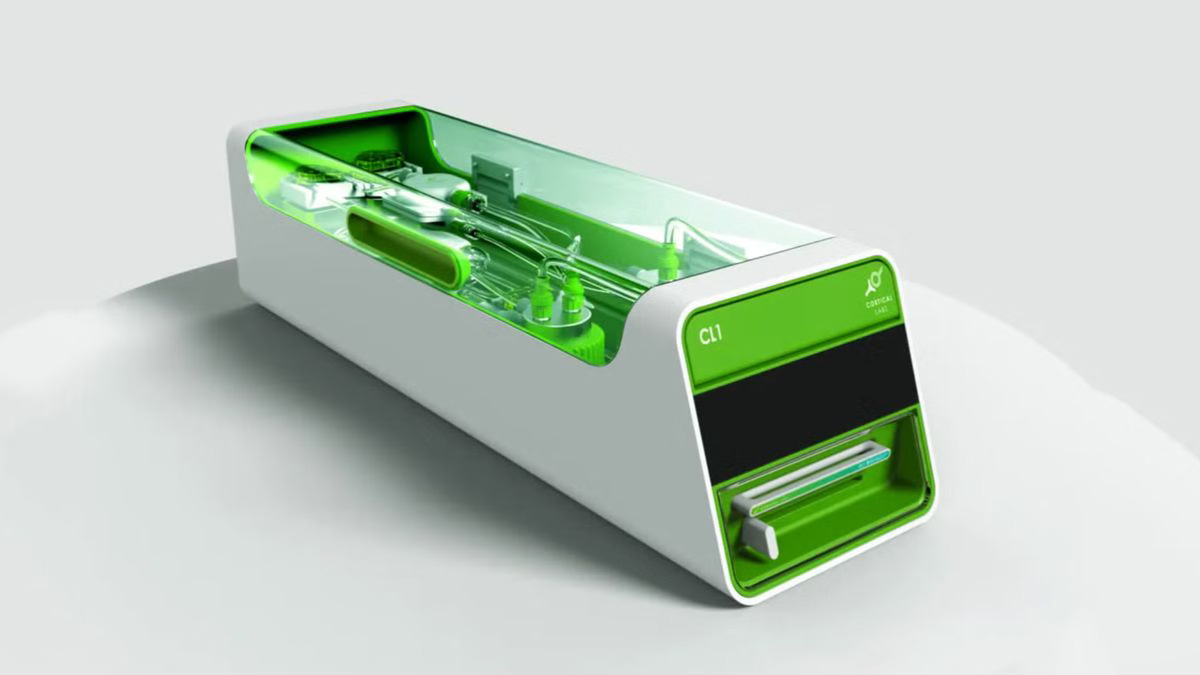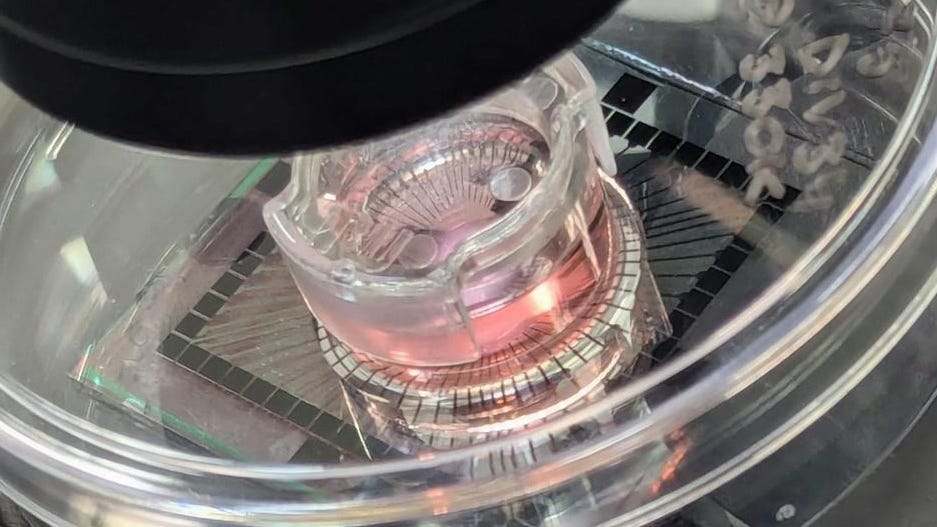The World's First Biological Computer Powered by Human Neurons
Exploring the Fusion of Human Neurons and Technology: Unveiling the World’s First Biological Computer
The technological landscape has witnessed a revolutionary breakthrough with the introduction of CL1, the world's first commercially viable biological computer that integrates living human brain cells with traditional silicon hardware. Developed by Australian biotech company Cortical Labs and officially unveiled in March 2025, this groundbreaking system represents a paradigm shift in computing technology, classified as "Synthetic Biological Intelligence" (SBI). CL1 harnesses the adaptive learning capabilities of human neurons cultivated on silicon chips, creating a hybrid technology that promises unprecedented energy efficiency and processing capabilities. With applications spanning medical research, drug discovery, robotics, and neuroscience, CL1 marks the beginning of a new era that bridges the gap between biological and digital computing, potentially transforming how we approach artificial intelligence and machine learning.
The Technological Framework of CL1
The architectural foundation of CL1 represents a sophisticated integration of biological and digital components, creating a system unlike any conventional computing platform. At its core, CL1 utilises human neurons derived from induced pluripotent stem cells (iPSCs), which are meticulously cultivated on a silicon chip embedded with a 59-electrode array. This specialized array facilitates intricate bidirectional communication between the biological neurons and the digital system, enabling the neurons to receive electrical stimulation and transmit responses that can be recorded and analyzed. The arrangement essentially creates neural networks that process information in a manner similar to a biological brain, offering unique computational advantages that traditional silicon-based systems cannot replicate.
To maintain the viability of these living components, CL1 incorporates an advanced life support system that has been engineered to sustain the neurons for up to six months. This support system effectively functions as a "body in a box," regulating critical parameters including temperature, gas exchange, filtration, and media circulation through a sophisticated arrangement of pumps and environmental controls. The rectangular life-support unit houses the SBI "brain" and connects to software-based systems for real-time operation, eliminating the need for external computers to function. This self-contained design significantly streamlines setup and implementation while reducing operational complexity.
Software and Interface Systems
The software architecture of CL1 is built upon a proprietary Biological Intelligence Operating System (biOS), which manages the complex interactions between the biological and digital elements of the system. To enhance accessibility and application development, Cortical Labs has implemented a Python API, providing researchers and developers with a familiar programming interface to interact with the biological computing platform. This thoughtful approach to software design ensures that CL1 remains accessible to a wide range of users, from neuroscientists to AI researchers, without requiring specialized programming knowledge.
Operational Capabilities and Technological Advantages
CL1’s hybrid biological-digital design offers major benefits over traditional computing, especially in energy efficiency and adaptive learning. Unlike conventional AI, which demands high power, CL1’s biological components enable ultra-low energy consumption—an entire rack uses just 850-1,000 watts. This efficiency comes from biological neurons, which naturally process information with minimal energy.
CL1’s most groundbreaking feature is its adaptive learning. Its biological neurons form networks that reorganize in response to input, allowing it to learn dynamically without explicit reprogramming—something traditional AI struggles with. Research by Cortical Labs has shown that neuron-based systems can even learn to play simple games like Pong, demonstrating their potential.
Processing Capabilities and Scale
CL1’s neural networks operate on a scale similar to small insects like honeybees or cockroaches. While smaller than larger biological brains, this marks a major step in biological computing, offering enough capacity for complex tasks. Under a microscope, the neurons form visible branching connections, continuously adapting to new information.
To enhance scalability, Cortical Labs is building a biological neural network server stack. Each stack contains 30 units with neurons on electrode arrays, and they plan to have four stacks running commercially via the cloud by the end of 2025. This scaling effort could lead to more advanced neural networks capable of solving increasingly complex problems.
Applications and Potential Impact
CL1 has wide applications across science and industry, especially in medical research and robotics. In drug discovery, it could transform testing by creating biologically realistic neural environments, helping researchers study how drugs interact with human brain cells. This could speed up treatments for neurological disorders and reduce reliance on animal testing.
In robotics, CL1’s adaptive neural networks could make robots more responsive and intuitive. Unlike traditional AI, which relies on pre-programmed rules, biologically powered robots could adjust to new environments more efficiently. This would be especially useful in search and rescue missions or exploratory tasks in unpredictable conditions.
Cloud Computing and Remote Access
Cortical Labs’ “Wetware-as-a-Service” (WaaS) model makes biological computing more accessible by allowing researchers to use CL1 systems remotely via the cloud. This eliminates the need for costly hardware and maintenance. As Cortical Labs states, the platform enables global innovators to turn CL1’s potential into real-world impact.
By offering cloud access, CL1 becomes available to more institutions and individuals who might lack the resources for direct deployment. It also supports collaborative research across locations, speeding up innovation. Additionally, Cortical Labs can refine the platform based on user feedback, improving its performance over time.
Development History and Technical Evolution
CL1’s development began with Cortical Labs’ earlier “DishBrain” system, which showed that neurons could interact with digital environments by learning to play Pong. This research, published in Neuron, proved that biological neurons could process information and respond to stimulation, paving the way for CL1.
In 2023, Cortical Labs secured $15 million in funding to improve CL1’s stability, energy efficiency, and programmability. Their focus was on maintaining stable neural networks over time and refining the interface between biological and digital components. The latest versions are designed to be simpler yet more stable, ensuring better control and reliability.
Technical Breakthroughs and Innovations
The transition from DishBrain to CL1 involved key technical advancements. The team refined the planar electrode array, stabilising it with a 59-electrode configuration. They also developed a life support system to keep neurons viable, solving a major challenge in biological computing.
A major breakthrough was the creation of the biOS operating system and a Python API, turning CL1 from an experimental concept into a practical research tool. This software allows users to interact with biological neurons using familiar programming interfaces, broadening CL1’s applications beyond neuroscience into mainstream research and development.
Ethical Considerations and Regulatory Landscape
The use of human neurons in computing raises important ethical concerns, especially regarding potential sentience in synthetic neural networks. While CL1’s lab-grown neurons are not conscious, future advancements in biological computing may require deeper ethical scrutiny. Cortical Labs recognizes these concerns and stresses the need for responsible development.
Regulatory compliance is also crucial for CL1’s deployment. It must meet health, bioethics, and government standards, which may vary by location and application. The requirement for Physical Containment Level 2 (PC2) labs highlights the strict regulations governing the development and maintenance of such systems.
Future Ethical Challenges
As biological computing technology advances, new ethical questions may emerge regarding the rights and status of increasingly complex synthetic neural networks. The potential for emergent properties in larger, more sophisticated neural systems could challenge existing ethical frameworks and require new approaches to responsible innovation. Additionally, the use of human-derived cells in computing raises questions about consent, ownership, and the appropriate limits of biological manipulation in technological contexts.
The development of clear ethical guidelines and regulatory frameworks specific to biological computing will be essential as the field continues to evolve. Industry collaboration with ethicists, policymakers, and other stakeholders could help establish standards that balance innovation with responsible development, ensuring that the benefits of biological computing can be realized while minimizing potential risks and ethical concerns.
Comparison to Traditional Computing Technologies
CL1 stands out from traditional AI and neuromorphic computing by combining biological processes with digital technology. Unlike silicon-based AI, which relies on algorithms and mathematical models, CL1 uses real biological neurons for adaptive learning and information processing.
This key difference gives CL1 unique advantages. Traditional AI, especially deep learning models, demands massive computational power and energy. In contrast, CL1 operates with far greater energy efficiency, handling complex tasks with a fraction of the power. Its biological neurons also allow for more flexible responses to new or unpredictable situations—an area where conventional AI often struggles.
Conclusion
The introduction of CL1 marks a watershed moment in the evolution of computing technology, representing the first commercially viable integration of biological neurons with digital systems. This innovative approach to computing offers unique advantages in energy efficiency and adaptive learning, potentially opening new avenues for applications in medical research, robotics, and beyond. By making this technology accessible through both direct hardware purchase and cloud-based services, Cortical Labs has established a foundation for broader exploration and application of biological computing principles.
The journey from concept to commercial product has involved numerous technical challenges and breakthroughs, culminating in a system that maintains the viability of human neurons while harnessing their computational capabilities in a controlled environment. The resulting platform balances biological complexity with practical usability, creating a bridge between neuroscience and computing that could influence both fields for years to come.
As biological computing continues to evolve, new questions will arise regarding ethical implications, regulatory frameworks, and technical capabilities. The response to these questions will shape the trajectory of the field and determine how biological computing technologies like CL1 integrate into the broader technological landscape. Regardless of the specific path forward, the development of CL1 represents a significant milestone in the ongoing convergence of biology and technology, with potential implications that extend far beyond conventional computing paradigms.
Citations:
https://newatlas.com/brain/cortical-bioengineered-intelligence/
https://cosmosmagazine.com/technology/computing/first-biological-computer-neurons/




